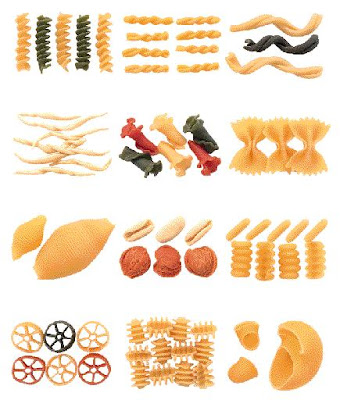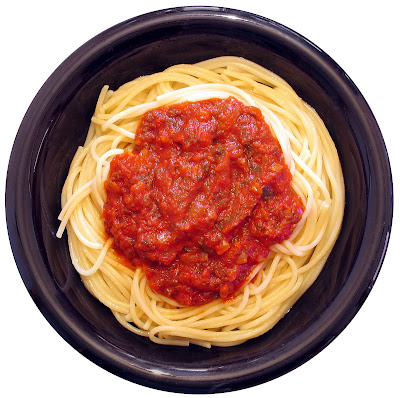
You may have noticed that Myra cooks a lot of pasta dishes, even before Frances came on the scene. This isn't just because of Ginny's world-class marinara: it's because cooking with pasta is a great way to enrich your eating pleasure.
I eat a lot of pasta. It's an extremely healthy, satisfying meal if done right. To begin with, get whole-grain or vegetable-based pasta if you are buying the dried kind. White flour pressed into shapes is still white flour, and all the hoo-ha about carbs being bad for you is really just another way of saying don't eat white flour. We NEED grains, but go for whole grains which won't spike your blood sugar or leave you craving more in an hour. If possible, buy fresh pasta; you can freeze this and still get mostly the same flavor and benefit. Plus, the cooking time is extremely short, often just a minute, with the fresh stuff.
I don't use jarred pasta sauces. I can make delicious sauces (and so can you) in less than five minutes by using equal amounts of butter and really good olive oil (you need both for flavor) to sautee chopped onion and any fresh or frozen vegetable for five minutes. Add minced garlic, pepperincino flakes, and a fresh herb or two for the last minute, and you're done. Sauces should be to dress pasta, not drown it -- especially if you're starting with good pasta in the first place. Sprinkle on cheese after you plate the pasta and sauce.
Use a lot of water to boil your pasta, to keep it from sticking. Add salt, generously, to the boiling water -- this will not be showing up in the final dish, don't worry about it. NEVER add oil to your pasta water, you ruin the ability of the sauce to marry with the sticky pasta if you do. Scoop out the pasta when nearly done and add it to your sauce, so it blends and finishes cooking in the sauce. Save the pasta water to thin your sauce if necessary, it's full of nutrients.
Pasta has a long history, even longer if you factor in noodles which were brought to Italy from China by Marco Polo. Each small region in Italy has developed its own pasta shapes and uses. Try buying a variety of shapes and experiment with making your own sauces. Here's some help to get you started.
JARRED PASTA SAUCES: (f you must)
Cook's Illustrated recommended Bertolli tomato and basil sauce, Francesco Rinaldi traditional marinara, Prego marinara, Barilla marinara, Newman's Own marinara, and Muir Glen organic tomato basic sauce (all with some qualifiers, see link for details).
Check out America's Test Kitchen video on how to make a great 45 minutes marinara sauce for pasta.
MATCHING PASTA SHAPES WITH SAUCE (from Cook's Illustrated):
Are there any rules in matching pasta shapes with sauce? In Italy there is a fine art to matching pasta shapes and sauces, but here at Cook’s, we are a bit freer with the pairing and endorse just one general rule: you should be able to eat the pasta and sauce easily in each mouthful. This means that the texture and consistency of the sauce should work with the pasta shape. And no matter what the shape of the pasta or type of sauce, we adamantly believe that the pasta, not the sauce, should be the focal point.
Long strands are best with smooth sauces or pestos, or sauces with very small chunks such as oil and garlic. In general, wider long noodles, such as fettuccine, can more easily support slightly chunkier sauces than can very thin noodles like spaghetti. Wide pastas like fettuccine or tagliatelle are also well suited to creamy sauces like Alfredo.
Short tubular or molded pasta shapes do an excellent job of trapping chunkier sauces. Sauces with very large chunks are best with shells, rigatoni, or other large tubes. Sauces with small to medium chunks make more sense with fusilli or penne.
My addendum: Pasta that's great for soups include acini de pepe, anellini, capellini, conchiglie, ditalini, egg noodles, fideo, orzo, or tripolini.
IDENTIFYING PASTA SHAPES (from the National Pasta Association and Cook's Thesaurus: (Acini de pepe or peppercorn) -- Soups and broths
(Acini de pepe or peppercorn) -- Soups and broths (Anellini) -- Soups, complements to salads
(Anellini) -- Soups, complements to salads (Bucatini, hollow in the center) -- Good for almost any sauce, casseroles or stir-fry.
(Bucatini, hollow in the center) -- Good for almost any sauce, casseroles or stir-fry. (Campanelle or bells) -- Great with meat, cream, vegetable or oil based sauces, also good in salads
(Campanelle or bells) -- Great with meat, cream, vegetable or oil based sauces, also good in salads (Capellini or angel hair, means fine hairs) -- Best in thin, delicate sauces; also break in half and use in soups or stir-fry
(Capellini or angel hair, means fine hairs) -- Best in thin, delicate sauces; also break in half and use in soups or stir-fry (Cappalletti, means little hats) -- Good for medium chunkier sauces
(Cappalletti, means little hats) -- Good for medium chunkier sauces (Casarecci or cesariccia) -- Usually served with meat sauces, also good in casseroles
(Casarecci or cesariccia) -- Usually served with meat sauces, also good in casseroles (Cavatappi, means corkscrew) -- Good with meat, cream, vegetable or oil based sauces, also good in pasta salads
(Cavatappi, means corkscrew) -- Good with meat, cream, vegetable or oil based sauces, also good in pasta salads (Cavatelli, looks like tiny hot dog buns) -- Commonly served with thick, chunky sauces or in pasta salads, pairs nicely with meat, cream, seafood or vegetable sauces
(Cavatelli, looks like tiny hot dog buns) -- Commonly served with thick, chunky sauces or in pasta salads, pairs nicely with meat, cream, seafood or vegetable sauces (Conchiglie, also called small pasta shells, pipe rigate, or maruzze) -- Often served with tomato or meat sauces, or in pasta salads
(Conchiglie, also called small pasta shells, pipe rigate, or maruzze) -- Often served with tomato or meat sauces, or in pasta salads (Conchiglioni or jumbo shells) -- Best when stuffed with your favorite mixtures of cheese, meat and vegetables
(Conchiglioni or jumbo shells) -- Best when stuffed with your favorite mixtures of cheese, meat and vegetables (Creste di galli, means cockscomb) -- Can be topped with any sauce, baked, or put in soups, salads and stir-fry dishes
(Creste di galli, means cockscomb) -- Can be topped with any sauce, baked, or put in soups, salads and stir-fry dishes (Ditalini, means little thimbles) -- Can be used as the base of any dish, bake it, stir it into soups, or create great salads and stir-fry dishes
(Ditalini, means little thimbles) -- Can be used as the base of any dish, bake it, stir it into soups, or create great salads and stir-fry dishes (Egg noodles, come in medium and wide) -- Traditionally used for stroganoff; can be baked, tossed in soups or salads, or topped with cream, tomato, cheese or meat sauces
(Egg noodles, come in medium and wide) -- Traditionally used for stroganoff; can be baked, tossed in soups or salads, or topped with cream, tomato, cheese or meat sauces (Farfalle or bowties) -- Smaller version is called farfallini, larger version is called farfallone; often served with chunky sauces or in pasta salads
(Farfalle or bowties) -- Smaller version is called farfallini, larger version is called farfallone; often served with chunky sauces or in pasta salads (Fettuccini) -- Also called tagliatelle. Classically served with meat sauce or Bolongnese, also popular with Alfredo.
(Fettuccini) -- Also called tagliatelle. Classically served with meat sauce or Bolongnese, also popular with Alfredo. (Fideo) -- Commonly used in soup
(Fideo) -- Commonly used in soup (Fusilli or twisted spaghetti) -- Can be topped with any sauce, broken in half and added to soups, or turned into a beautiful salad; also bakes well in casseroles
(Fusilli or twisted spaghetti) -- Can be topped with any sauce, broken in half and added to soups, or turned into a beautiful salad; also bakes well in casseroles (Fusilli col buco) -- Good choice for pasta salads and casseroles, or for serving with hearty, thick sauces
(Fusilli col buco) -- Good choice for pasta salads and casseroles, or for serving with hearty, thick sauces (Gemelli, means twins) -- Great with any sauce, or in pasta salads or casseroles
(Gemelli, means twins) -- Great with any sauce, or in pasta salads or casseroles (Gigli, means lilies or death to Ben Affleck's career) -- Perfect for heavier sauces, like cheese, meat and tomato or it is a good addition to a number of casseroles
(Gigli, means lilies or death to Ben Affleck's career) -- Perfect for heavier sauces, like cheese, meat and tomato or it is a good addition to a number of casseroles (Gnochette, made to look like gnocchi, the popular potato dumplings) -- Good with thick sauces
(Gnochette, made to look like gnocchi, the popular potato dumplings) -- Good with thick sauces (Gramigna) -- Good with light sauces
(Gramigna) -- Good with light sauces (Lasagna, From “lasanum,” Latin for pot) -- Create original lasagna casseroles by using chopped vegetables, cheeses and any kind of sauce
(Lasagna, From “lasanum,” Latin for pot) -- Create original lasagna casseroles by using chopped vegetables, cheeses and any kind of sauce (Linguini, means little tongues) -- Good with most sauces.
(Linguini, means little tongues) -- Good with most sauces. (Lumacone, means giant snails) -- Usually stuffed and baked
(Lumacone, means giant snails) -- Usually stuffed and baked (Macaroni, also called elbow macaroni, means dumpling) -- A highly versatile shape that can be topped with any sauce, baked, or put in soups, salads and stir-fry dishes
(Macaroni, also called elbow macaroni, means dumpling) -- A highly versatile shape that can be topped with any sauce, baked, or put in soups, salads and stir-fry dishes (Malloreddus) -- A Sardinian pasta very similar to gnocchetti, except that it's often flavored with saffron
(Malloreddus) -- A Sardinian pasta very similar to gnocchetti, except that it's often flavored with saffron (Maltagliati) -- Means "poorly cut" in Italian, and the name is used for various kinds of pasta scraps; great addition to casseroles or thick sauces
(Maltagliati) -- Means "poorly cut" in Italian, and the name is used for various kinds of pasta scraps; great addition to casseroles or thick sauces (Manicotti, means small muffs) -- Stuff with a mixture of meat, cheese and vegetables, top with your favorite sauce, and bake
(Manicotti, means small muffs) -- Stuff with a mixture of meat, cheese and vegetables, top with your favorite sauce, and bake (Orecchiette, means little ears) -- Commonly served with thick, chunky sauces or in pasta salads
(Orecchiette, means little ears) -- Commonly served with thick, chunky sauces or in pasta salads (Orzo, means barley) -- Can be topped with any sauce, added to soups, or baked as a casserole. Perfect as a side dish as well as a main course
(Orzo, means barley) -- Can be topped with any sauce, added to soups, or baked as a casserole. Perfect as a side dish as well as a main course (Penne, means quills or feathers) -- Smaller size is called mostaccioli, means little mustaches. Ridged version is called penne rigate and is ideal to lock-in flavor. Pairs nicely with chunky meat, chunky vegetable, cream, or oil based sauces; great for baking dishes
(Penne, means quills or feathers) -- Smaller size is called mostaccioli, means little mustaches. Ridged version is called penne rigate and is ideal to lock-in flavor. Pairs nicely with chunky meat, chunky vegetable, cream, or oil based sauces; great for baking dishes (Pipe rigate) -- Smaller version called pipette rigate. Pairs nicely with chunky meat, chunky vegetable, cream, or oil based sauces
(Pipe rigate) -- Smaller version called pipette rigate. Pairs nicely with chunky meat, chunky vegetable, cream, or oil based sauces (Quadrefiore) -- Pairs nicely with chunky meat, chunky vegetable, cream, or oil based sauces; great for baking dishes
(Quadrefiore) -- Pairs nicely with chunky meat, chunky vegetable, cream, or oil based sauces; great for baking dishes (Radiatori, means radiators) -- Do a good job of scooping up chunky sauces; also good in casseroles, salads and soups
(Radiatori, means radiators) -- Do a good job of scooping up chunky sauces; also good in casseroles, salads and soups (Ravioli) -- Fill with cheese, meats, vegetables and seasonings; serve with a red sauce. butter, oil or cream
(Ravioli) -- Fill with cheese, meats, vegetables and seasonings; serve with a red sauce. butter, oil or cream (Reginette) -- Wide, flat ribbon pasta that has rippled edges on both sides, use like lasagna
(Reginette) -- Wide, flat ribbon pasta that has rippled edges on both sides, use like lasagna (Riccioli, means curl) -- Twisted shape holds bits of meat, vegetables and cheese, so it works well with a variety of sauces, or create fun salads, baked casseroles, or stir-fry meals
(Riccioli, means curl) -- Twisted shape holds bits of meat, vegetables and cheese, so it works well with a variety of sauces, or create fun salads, baked casseroles, or stir-fry meals (Rigatoni, means large grooved) -- Perfect with any sauce, from cream or cheese to the chunkiest meat sauces
(Rigatoni, means large grooved) -- Perfect with any sauce, from cream or cheese to the chunkiest meat sauces (Rocchetti, means spools) -- Perfect for preparing casseroles and salads
(Rocchetti, means spools) -- Perfect for preparing casseroles and salads (Rotini) -- Works well with chunky sauces, or create fun salads, baked casseroles, or stir-fry meals
(Rotini) -- Works well with chunky sauces, or create fun salads, baked casseroles, or stir-fry meals (Ruote, means wheels) -- Also called ruotine. Pairs nicely with meat, cream, seafood or vegetable sauces, popular in pasta salads
(Ruote, means wheels) -- Also called ruotine. Pairs nicely with meat, cream, seafood or vegetable sauces, popular in pasta salads (Spiralini) -- Larger version called spirali. Good with chunky sauces, or in pasta salads
(Spiralini) -- Larger version called spirali. Good with chunky sauces, or in pasta salads (Strozzapreti, means priest strangler) -- Resembles a rolled towel. Pairs nicely with meat, cream, seafood and vegetable sauces
(Strozzapreti, means priest strangler) -- Resembles a rolled towel. Pairs nicely with meat, cream, seafood and vegetable sauces
Tagliatelle -- see fettuccini (Torchio) -- Little torches good for scooping up chunky sauces
(Torchio) -- Little torches good for scooping up chunky sauces (Tortellini) -- Typically stuffed with meat, cheese or vegetables, commonly served in a broth or cream sauce
(Tortellini) -- Typically stuffed with meat, cheese or vegetables, commonly served in a broth or cream sauce (Tortiglioni) -- Commonly used to add decoration to salads or paired with a simple sauce
(Tortiglioni) -- Commonly used to add decoration to salads or paired with a simple sauce (Trenne) -- Triangular and cut into short lengths, with smaller version called trennette. Don't confuse this with trenette, which is a long ribbon of pasta. Good with chunky sauces or in casseroles
(Trenne) -- Triangular and cut into short lengths, with smaller version called trennette. Don't confuse this with trenette, which is a long ribbon of pasta. Good with chunky sauces or in casseroles (Tripolini) -- A tiny bow tie shaped pasta used in soups and salads or paired with a simple sauce
(Tripolini) -- A tiny bow tie shaped pasta used in soups and salads or paired with a simple sauce (Troffiette) -- A Ligurian specialty, these small, twisted bits of pasta often served with pesto
(Troffiette) -- A Ligurian specialty, these small, twisted bits of pasta often served with pesto (Tubini) -- Perfect for chunky sauces and meat dishes, also good in salads, baked dishes and stir-fry meals
(Tubini) -- Perfect for chunky sauces and meat dishes, also good in salads, baked dishes and stir-fry meals (Vermicelli, means little worms) -- Good with thin, smooth sauces or pesto
(Vermicelli, means little worms) -- Good with thin, smooth sauces or pesto (Ziti, means bridegrooms) -- Perfect for chunky sauces and meat dishes
(Ziti, means bridegrooms) -- Perfect for chunky sauces and meat dishes
Friday, September 19, 2008
BASTA PASTA
Posted by
Maggie Jochild
at
11:29 PM
![]()
Labels: jarred pasta sauces, marinara sauce, Pasta shapes, recipes
Subscribe to:
Post Comments (Atom)





3 comments:
I use jarred sauce as a base sometimes, and add italian sausage, or chicken, plus some red wine and whatever else. For that I always use Trader Joe's basic marinara. It's just tomatoes, basil, olive oil, garlic. No scary ingredients like in the Bertolli and other commercial sauces. It's also incredibly cheap. About a dollar for a jar.
I think that whole-wheat pasta goes incredibly well with pesto. The heartier flavor of the pasta matches the sauce really well.
I wish we had Trader Joe's here. You're right, Kat, with that list of ingredients and your smart add-ins, I'd try the jar version, too. Another reason to live in Seattle...
I'm just sad that this year, the price of 1 jar went up from $.99 to $1.19....
The only reason I didn't starve when I was in school in London was that I could buy a pound (or 500g or something) of pasta for 16p. That works out to about $.32!
Post a Comment